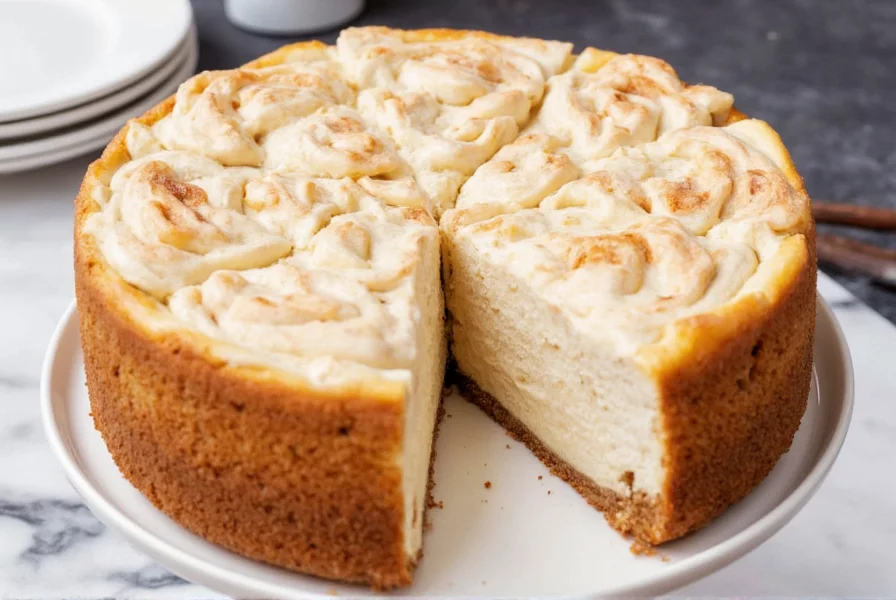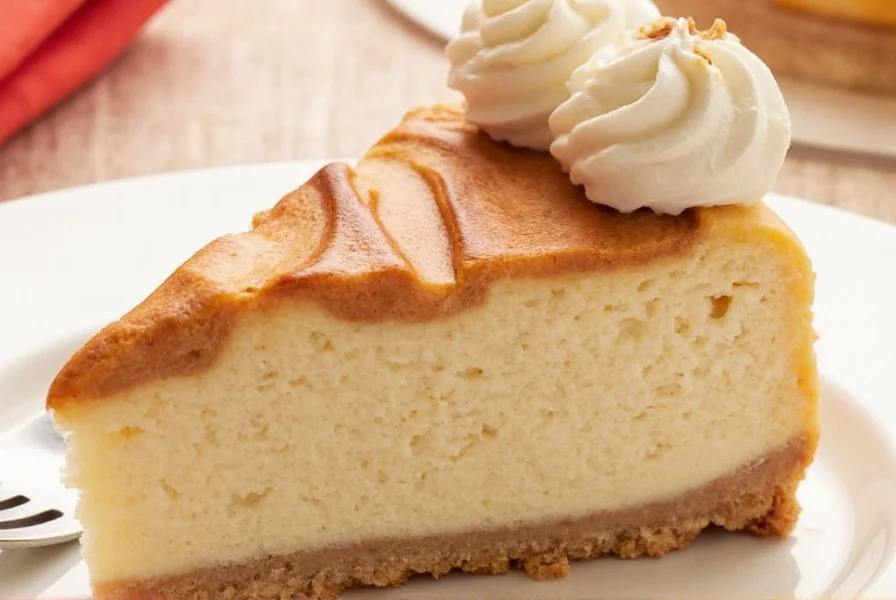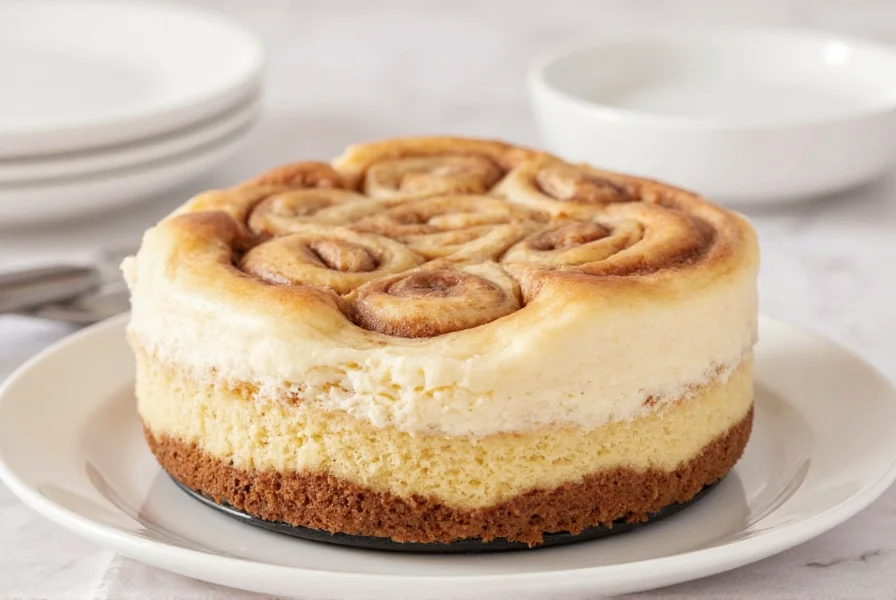If you love the warm spices of cinnamon rolls and the creamy richness of cheesecake, this hybrid dessert delivers the best of both worlds. Unlike standard cheesecake recipes, this version incorporates cinnamon swirls directly into the cheesecake batter while using a modified cinnamon roll dough as the base. The result is a show-stopping dessert that's surprisingly approachable for home bakers with basic cheesecake experience.
Why This Cinnamon Bun Cheesecake Recipe Works
Most attempts at combining cinnamon rolls and cheesecake end up with structural issues—either the swirls sink to the bottom or the dough doesn't cook through properly. Our tested method solves these common problems by using a thicker cinnamon filling and a specific layering technique that ensures even distribution of flavors while maintaining proper texture throughout.

Complete Ingredient List
Gather these ingredients before starting. All measurements are precise for optimal results—baking is a science, especially with cheesecake.
| Component | Ingredients | Measurements |
|---|---|---|
| Cinnamon Roll Crust | All-purpose flour | 1 ½ cups |
| Unsalted butter, cold | ½ cup | |
| Granulated sugar | ¼ cup | |
| Cinnamon | 1 tbsp | |
| Cheesecake Filling | Cream cheese, full-fat, room temperature | 32 oz (4 packages) |
| Granulated sugar | 1 cup | |
| Large eggs, room temperature | 4 | |
| Heavy cream | ¼ cup | |
| Vanilla extract | 2 tsp | |
| Cinnamon Swirl | Brown sugar | ½ cup |
| Cinnamon | 2 tbsp | |
| Unsalted butter, melted | 2 tbsp | |
| Cream Cheese Glaze | Cream cheese, softened | 4 oz |
| Powdered sugar | 1 cup | |
| Milk | 2 tbsp |
Essential Equipment
- 9-inch springform pan (critical for clean removal)
- Stand mixer or hand mixer
- Parchment paper
- Aluminum foil (for water bath)
- Medium saucepan
- Cheesecake thermometer (optional but recommended)
Step-by-Step Instructions
Preparing the Cinnamon Roll Crust
- Preheat oven to 325°F (163°C). Wrap the outside of your springform pan tightly with aluminum foil to prevent water seepage during the water bath.
- Mix flour, sugar, and cinnamon in a bowl. Cut cold butter into small cubes and work into the flour mixture using a pastry cutter until it resembles coarse crumbs.
- Press mixture firmly and evenly into the bottom of the prepared springform pan. Bake for 15 minutes until lightly golden. Cool completely.
Creating the Cinnamon Swirl Mixture
- Combine brown sugar and cinnamon in a small saucepan. Add melted butter and cook over medium heat for 3 minutes, stirring constantly, until mixture thickens slightly. Cool to room temperature (this prevents the swirl from sinking).
Preparing the Cheesecake Filling
- Beat cream cheese on medium speed until completely smooth and creamy (about 3 minutes). Scrape down sides frequently.
- Add sugar gradually, beating until fully incorporated. Add eggs one at a time, mixing just until combined after each addition.
- Mix in heavy cream and vanilla. Do not overmix at this stage to prevent air bubbles.
Assembling and Baking
- Pour half of the cheesecake batter over the cooled crust. Using an offset spatula, spread evenly.
- Drizzle half of the cooled cinnamon swirl mixture over the batter. Use a knife to gently marbleize.
- Add remaining cheesecake batter, then top with remaining cinnamon swirl. Marbleize again with a knife.
- Place springform pan in a larger roasting pan. Fill roasting pan with hot water until it reaches halfway up the sides of the springform pan.
- Bake at 325°F for 60-75 minutes until edges are set but center still jiggles slightly when gently shaken.
- Turn off oven, crack door open, and let cheesecake cool in oven for 1 hour. This prevents cracking.
- Remove from oven and water bath. Run a thin knife around the edge (this prevents cracks during cooling). Chill in refrigerator for at least 4 hours, preferably overnight.
Pro Tips for Cinnamon Bun Cheesecake Success
- Room temperature ingredients are non-negotiable—cold cream cheese creates lumps that won't fully incorporate, leading to a grainy texture.
- Don't skip the water bath—it creates gentle, even heat that prevents cracking and ensures creamy texture throughout.
- Cool gradually—the slow cooling process in the turned-off oven prevents dramatic temperature changes that cause cracks.
- Use full-fat cream cheese—reduced fat versions contain stabilizers that can make your cheesecake rubbery.
- Thicken your cinnamon swirl—cooking the swirl mixture prevents it from sinking to the bottom during baking.
Common Mistakes to Avoid
Even experienced bakers encounter issues with cinnamon bun cheesecake recipes. Here's how to avoid the most frequent problems:
- Sunken cinnamon swirls: This happens when the swirl mixture is too thin. Our recipe solves this by cooking the swirl mixture first to thicken it.
- Cracked surface: Caused by overbaking, rapid cooling, or overmixing. Follow our gradual cooling method and don't open the oven during baking.
- Soggy crust: Ensure your crust is fully baked and cooled before adding filling, and properly wrap the pan for the water bath.
- Undercooked center: Use an instant-read thermometer—cheesecake is done when the internal temperature reaches 150°F (65°C) at the center.
Serving and Storage Recommendations
For clean slices, dip a sharp knife in hot water and wipe dry between cuts. Serve with additional cream cheese glaze or a dollop of whipped cream.
Storage: Keep covered in the refrigerator for up to 5 days. For longer storage, wrap individual slices tightly in plastic wrap and freeze for up to 2 months. Thaw in the refrigerator overnight before serving.
Make-ahead tip: Prepare the crust and cinnamon swirl mixture one day in advance. Store crust at room temperature and swirl in the refrigerator until ready to use.
Variations to Try
- Streusel topping: Add a crumb topping during the last 10 minutes of baking for extra texture.
- Bacon cinnamon swirl: Incorporate 2 tablespoons of finely chopped candied bacon into the cinnamon swirl mixture.
- Vegan version: Use plant-based cream cheese, coconut cream, and a flax egg substitute (results will vary in texture).
- Mini cinnamon bun cheesecakes: Prepare in a muffin tin for individual portions (reduce baking time to 25-30 minutes).

Frequently Asked Questions
Can I make this cinnamon bun cheesecake without a water bath?
While possible, we strongly recommend using a water bath for optimal results. The steam creates gentle, even heat that prevents cracking and ensures a creamy texture throughout. Without a water bath, you're more likely to get a rubbery texture and surface cracks. If you must skip it, reduce oven temperature to 300°F and monitor closely.
Why did my cinnamon swirl sink to the bottom of the cheesecake?
This typically happens when the cinnamon swirl mixture is too thin. Our recipe solves this by cooking the brown sugar, cinnamon, and butter mixture for 3 minutes to thicken it before cooling. If making your own swirl, ensure it has a paste-like consistency—not liquidy—before adding to the cheesecake batter.
How can I prevent cracks in my cinnamon bun cheesecake?
Prevent cracks by: 1) Not overmixing the batter after adding eggs, 2) Using a water bath during baking, 3) Cooling gradually in a turned-off oven with the door cracked, 4) Running a knife around the edge immediately after baking, and 5) Ensuring proper internal temperature (150°F at center) rather than relying solely on time.
Can I use store-bought cinnamon roll dough for the crust?
Yes, but with modifications. Roll out store-bought dough and press into the pan, then bake for 10-12 minutes at 325°F before adding filling. Note that homemade crust (as in our recipe) yields better texture control and prevents sogginess. If using store-bought, reduce added sugar in the crust component as most contain significant sugar already.
How do I know when my cinnamon bun cheesecake is fully baked?
The edges should be set and slightly puffed, while the center (about the size of a quarter) should still jiggle slightly when gently shaken. For precision, use an instant-read thermometer—the center should register 150°F (65°C). The cheesecake will continue to set as it cools. Overbaking is the most common cause of cracked, dry cheesecake.











 浙公网安备
33010002000092号
浙公网安备
33010002000092号 浙B2-20120091-4
浙B2-20120091-4